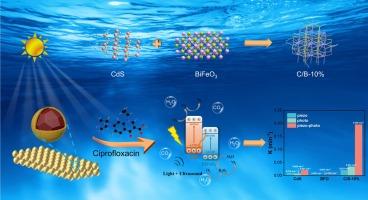双压电光催化剂CdS/BiFeO3 S-scheme异质结增强水生抗生素去除:机理、降解途径和毒性评价
IF 9.7
1区 化学
Q1 CHEMISTRY, PHYSICAL
引用次数: 0
摘要
压电光催化是一种有效且环保的水净化策略,其中单线态氧(1O2)由于其在废水降解过程中的特殊选择性和显着的氧化能力而成为关键的活性氧。为此,我们精心设计了一种双压电光催化剂,即硫化镉/铋铁氧体(CdS/BiFeO3)阶梯结构(S-scheme)异质结,以协同增强1O2的生成途径,从而有效去除抗生素污染物。本研究中,在超声振动和可见光照射的联合作用下,优化后的CdS/ bifeo3 - 10%降解环丙沙星(CIP)的反应速率常数为0.200 min−1,分别是单独的压催化和光催化的9.52倍和5.88倍。界面电场和振动压电场的协同作用显著促进了载流子分离,这得到了详细的实验和理论结果的支持。通过淬火实验和电子自旋共振(ESR),发现1O2和空穴(h+)在CIP降解中起主要作用。此外,系统地评价了CIP中间体的毒性和降解途径。CdS/BiFeO3复合材料还显示出出色的可重复使用性和循环稳定性,使其适用于实际的废水处理应用。这项工作强调了CdS/BiFeO3具有压电效应辅助S-scheme异质结的潜力,为高效的抗生素废水修复提供了一种新的有效的水净化策略。本文章由计算机程序翻译,如有差异,请以英文原文为准。

Enhanced aquatic antibiotic removal via dual piezoelectric photocatalyst CdS/BiFeO3 S-scheme heterojunction: Mechanism, degradation pathway, and toxicity evaluation
Piezo-photocatalysis represents an effective and eco-friendly strategy for water purification, wherein singlet oxygen (1O2) serves as a crucial reactive oxygen species due to its exceptional selectivity and remarkable oxidative capacity in wastewater degradation processes. Herein, we elaborately designed a dual piezoelectric photocatalyst, the Cadmium sulfide/Bismuth ferrite (CdS/BiFeO3) step-scheme (S-scheme) heterojunction to synergistically enhance generation pathways of 1O2 for efficient removal of antibiotic contaminants. In this study, under the combination of ultrasonic vibration and visible light irradiation, the optimized CdS/BiFeO3-10 % exhibited a reaction rate constant of 0.200 min−1 for ciprofloxacin (CIP) degradation, which was 9.52 and 5.88 times higher than that of individual piezocatalysis and photocatalysis, respectively. The synergistic effect of the interfacial electric field and the vibration-induced piezoelectric field significantly promoted charge carrier separation, as supported by detailed experimental and theoretical results. Through quenching experiment and Electron spin resonance (ESR), 1O2 and holes (h+) played major roles in CIP degradation. Furthermore, the toxicity and degradation pathways of CIP intermediates were systematically evaluated. The CdS/BiFeO3 composite also demonstrated outstanding reusability and cycle stability, making it suitable for practical wastewater treatment applications. This work highlights the potential of CdS/BiFeO3 with piezoelectric effect-assisted S-scheme heterojunction for highly efficient antibiotic wastewater remediation, offering a novel and effective strategy for water purification.
求助全文
通过发布文献求助,成功后即可免费获取论文全文。
去求助
来源期刊
CiteScore
16.10
自引率
7.10%
发文量
2568
审稿时长
2 months
期刊介绍:
The Journal of Colloid and Interface Science publishes original research findings on the fundamental principles of colloid and interface science, as well as innovative applications in various fields. The criteria for publication include impact, quality, novelty, and originality.
Emphasis:
The journal emphasizes fundamental scientific innovation within the following categories:
A.Colloidal Materials and Nanomaterials
B.Soft Colloidal and Self-Assembly Systems
C.Adsorption, Catalysis, and Electrochemistry
D.Interfacial Processes, Capillarity, and Wetting
E.Biomaterials and Nanomedicine
F.Energy Conversion and Storage, and Environmental Technologies

 求助内容:
求助内容: 应助结果提醒方式:
应助结果提醒方式:


